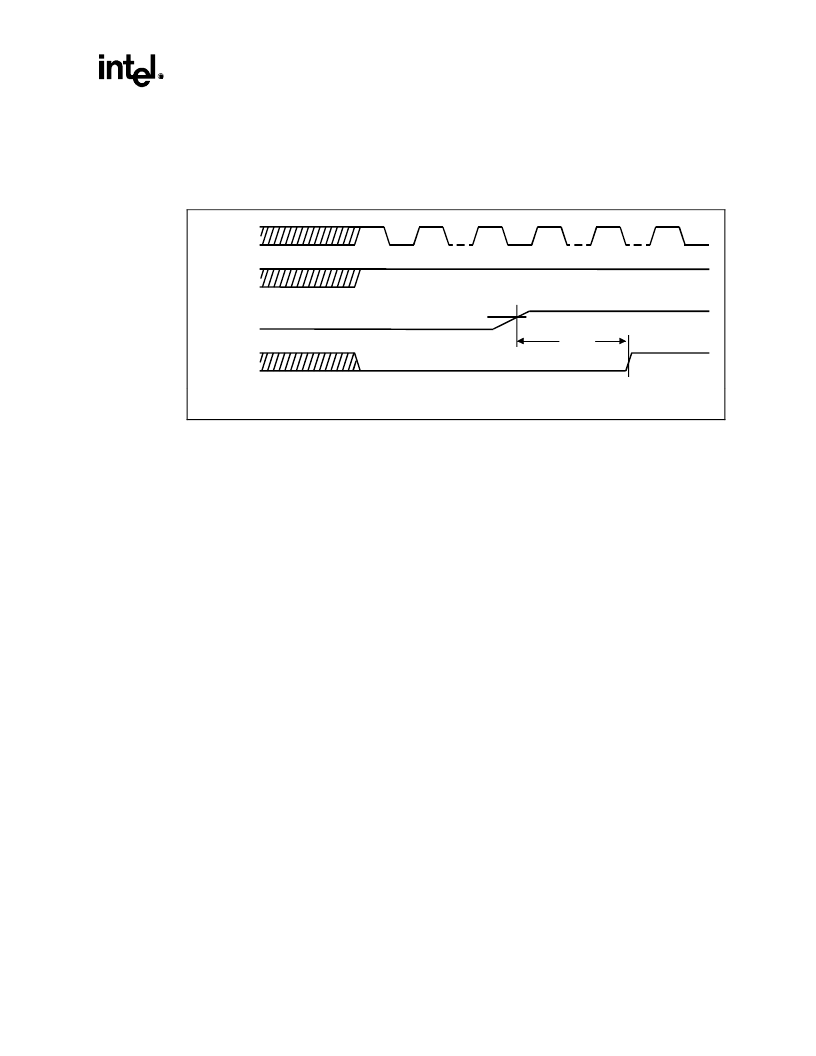- 您現(xiàn)在的位置:買賣IC網(wǎng) > PDF目錄369586 > RH8053GC029512 Microprocessor PDF資料下載
參數(shù)資料
| 型號: | RH8053GC029512 |
| 英文描述: | Microprocessor |
| 中文描述: | 微處理器 |
| 文件頁數(shù): | 71/81頁 |
| 文件大?。?/td> | 598K |
| 代理商: | RH8053GC029512 |
第1頁第2頁第3頁第4頁第5頁第6頁第7頁第8頁第9頁第10頁第11頁第12頁第13頁第14頁第15頁第16頁第17頁第18頁第19頁第20頁第21頁第22頁第23頁第24頁第25頁第26頁第27頁第28頁第29頁第30頁第31頁第32頁第33頁第34頁第35頁第36頁第37頁第38頁第39頁第40頁第41頁第42頁第43頁第44頁第45頁第46頁第47頁第48頁第49頁第50頁第51頁第52頁第53頁第54頁第55頁第56頁第57頁第58頁第59頁第60頁第61頁第62頁第63頁第64頁第65頁第66頁第67頁第68頁第69頁第70頁當(dāng)前第71頁第72頁第73頁第74頁第75頁第76頁第77頁第78頁第79頁第80頁第81頁

Mobile Intel
Celeron Processor (0.18μ) in BGA2 and Micro-PGA2 Packages
Order Number#249563-001
Datasheet
71
PWRGOOD. It must also meet the minimum pulse width specified in Table 16 (Section 3.6) and
be followed by a 1 ms RESET# pulse.
Figure 24. PWRGOOD Relationship at Power On
BCLK
PWRGOOD
RESET#
D0026-01
1 msec
V
IH25,min
V
CC
,
V
CCT
,
V
REF
The PWRGOOD signal, which must be supplied to the processor, is used to protect internal
circuits against voltage sequencing issues. The PWRGOOD signal should be driven high
throughout boundary scan operation.
REQ[4:0]# (I/O - GTL+)
The REQ[4:0]# (Request Command) signals must be connected to the appropriate pins/balls on
both agents on the system bus. They are asserted by the current bus owner when it drives A[35:3]#
to define the currently active transaction type.
RESET# (I - GTL+)
Asserting the RESET# signal resets the processor to a known state and invalidates the L1 and L2
caches without writing back Modified (M state) lines. For a power-on type reset, RESET# must
stay active for at least 1 msec after V
CC
and BCLK have reached their proper DC and AC
specifications and after PWRGOOD has been asserted. When observing active RESET#, all bus
agents will deassert their outputs within two clocks. RESET# is the only GTL+ signal that does
not have on-die GTL+ termination. A 56.2
1% terminating resistor connected to V
CCT
is
required.
A number of bus signals are sampled at the active-to-inactive transition of RESET# for the power-
on configuration. The configuration options are described in Section 7 and in the
Pentium
II
Processor Developer’s Manual
.
Unless its outputs are tri-stated during power-on configuration, after an active-to-inactive
transition of RESET#, the processor optionally executes its built-in self-test (BIST) and begins
program execution at reset-vector 000FFFF0H or FFFFFFF0H. RESET# must be connected to the
appropriate pins/balls on both agents on the system bus.
相關(guān)PDF資料 |
PDF描述 |
|---|---|
| RH8053GC033512 | Microprocessor |
| BXYP14 | BXYP14 - Waraktor |
| BXYP26 | Octal D-type flip flop with clear |
| BXYP42 | Quad 2-input OR gate |
| BXYP43 | BXYP43 - Waraktor |
相關(guān)代理商/技術(shù)參數(shù) |
參數(shù)描述 |
|---|---|
| RH80554RC009512 | 制造商:Rochester Electronics LLC 功能描述:- Bulk 制造商:Intel 功能描述: |
| RH80554RC021512 | 制造商:Rochester Electronics LLC 功能描述: 制造商:Intel 功能描述: |
| RH9711 | 制造商:Thomas & Betts 功能描述:Ring Tongue Terminal 54.35mm 19.55mm Electro-Tin |
| RH9731 | 制造商:Thomas & Betts 功能描述:Ring Tongue Terminal 54.35mm 19.55mm Electro-Tin |
| RH9731U | 制造商:Thomas & Betts 功能描述:Ring Tongue Terminal 54.35mm 19.55mm Electro-Tin |
發(fā)布緊急采購,3分鐘左右您將得到回復(fù)。